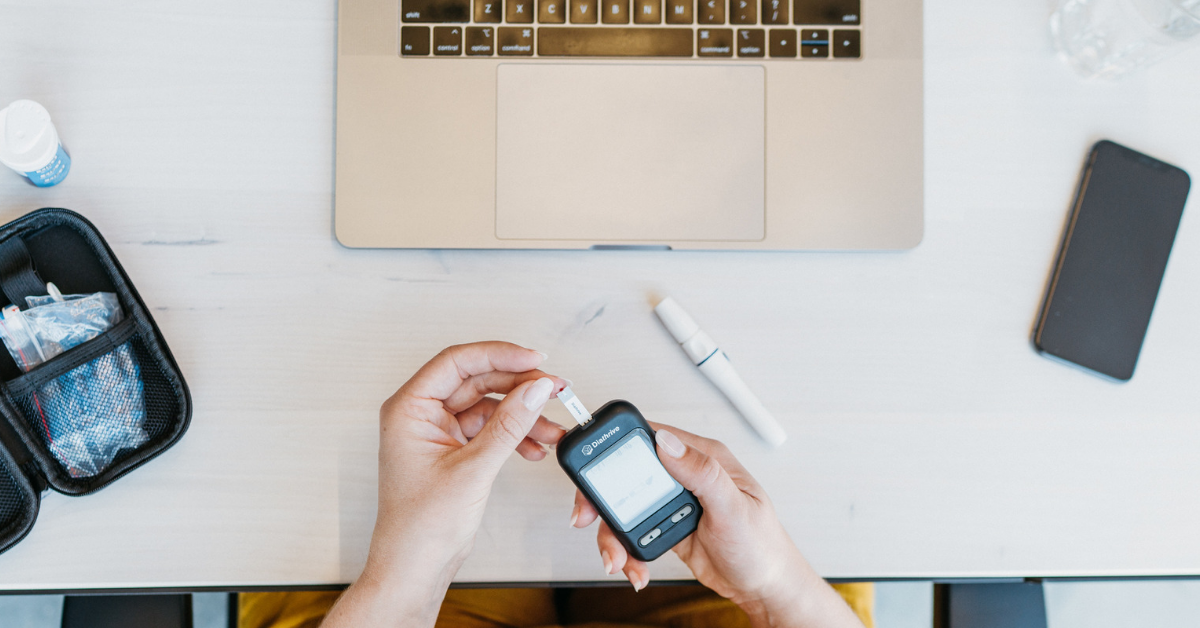So what do all of your glucose numbers mean? Carla Cox, CDE explains three common methods of seeing and understanding your blood sugar.
We are all familiar with the need to know where glucose is – whether at the present time or as it responds to the food we eat, the exercise we do or the medication we take. Here are 3 ways to understand your glucose numbers.
HbA1c
What is it?
A hemoglobin A1C is the average glucose over the course of 3 months. It is the amount of glucose that has become part of the hemoglobin (red blood cell) molecule and is an indirect measurement of your glucose. A recommended target should be is less than 7%. Your A1c will be checked during labs or in your provider’s office if they have the capability to do it. You and your provider will discuss what target is best for you based on your own personal history, including age and other conditions. Overall, this method of blood glucose measurement is essential for understanding diabetes health over time. A1C does have a correlation with risks of developing complications from diabetes. The higher the number, the greater the risk.
The challenge
A1c indicates an average. You could have glucose values in the 300 mg/dl range, and some in 40 mg/dl range and still have an A1C that is within target range. Along with your A1c, look at daily glucose test numbers to evaluate your time in range.
Finger Sticks: Home Glucose Meter and Test Strips
What is it?
The tried-and-true, go-to for checking and understanding blood glucose is with a home glucose meter. This technology has been around for decades and has improved in reliability and accuracy. The equipment needed to do this are:
-
Glucose meter
-
Test strips
-
Lancing device
-
Lancets
Most glucose values when you do a finger stick should be between 80 and 180 mg/dl. This measurement gives you information for just that one point in time. If every morning your glucose values are within goal, but every time you eat, those numbers rise to over 250 mg/dl, the after eating glucose values could be contributing to your risk for diabetes complications, particularly if they occur consistently after meals.
Or, perhaps your glucose values drop to less than goal every time you take a walk. Are you familiar with that outcome? Low blood glucose can make you feel weak and shaky and should be treated with a small amount of carbohydrate to bring you back into range. This measurement remains an important tool for most persons with diabetes to determine how food, exercise and medication impact your blood glucose level and whether you can remain within the target you and your provider have set for you.
The challenges
The finger-stick method is a manual process. It can be difficult to remember to check your blood sugar at times. Set up reminders on your meter or smartphone to help you remember to check at specific times, or make it a habit to take your meter out when you sit down for a meal.
Additionally, although this method is the most accurate way to get a glucose reading, it is never going to be 100% correct. All glucose meters are designed to show you what range you are in. So, although the number you see is more accurate than any other method, it is telling you a number within 15% of what your actual blood sugar might be at that moment. It could be spot on, or it could deviate a little further, depending on variables from your preparations to the glucose concentration within that specific drop of blood you are checking. Take your meter with you the next time you have lab work done and check your blood sugar to compare with your lab result and see how close yours is performing.
Finally, your home glucose monitor cannot tell you which direction your blood sugar is trending. It is a snapshot of the moment. This can be problematic if you are an insulin user. You will need to space out two checks two hours apart to see how well you calculated an insulin dose.
CGM: Continuous Glucose Monitor
What is it?
CGM (continuous glucose monitor) is the new kid on the block. These devices are measuring glucose every 5 minutes and sending the information to a receiver. There are 3 FDA approved CGM systems in the United States – each with unique characteristics. But the bottom line on using a CGM is that you can not only see the average glucose over time, and the glucose at that moment, but trends and patterns in glucose as well as impending high or low glucose. These numbers can be seen on a smartphone, smartwatch or a receiver. A small metal wire is inserted under the skin which collects the glucose information from fluid between your cells and transmits the information so that you can see it. CGM allows an individual to be able to determine the time in range – a more full assessment over time of outcomes in persons with diabetes than just an A1c or a finger stick. Recently 70% time in range (70-180 mg/dl)[16 ¾ hours per day] has been recommended for the best outcomes with less than 5% under 70 mg/dl and less than 25% above 180 mg/dl. These systems used independently or in conjunction with blood glucose monitoring provide the best picture of your glucose data. It is worth discussing this as an option with your health care provider.
The challenges
Accessibility. Most insurance companies cover the expense of a CGM system if you are on multiple daily injections of insulin and provide several months of multiple daily finger sticks to prove a need.
Delayed effect. A home glucose meter measure glucose currently in your blood, much like a lab. If your blood sugar rises quickly to reach 250 mg/dL on your meter, that glucose won’t affect your interstitial fluids for about 10 minutes. So, while CGM is accurate and the best way to collect and analyze glucose data, it is delayed during rapid changes. When symptoms don't match CGM, using a home glucose meter in conjunction with a CGM can help you make better insulin dosing decisions and increase your time in range.
Regardless of which system or systems you use to determine the glucose outcomes of life’s choices or circumstances, it is so important to keep an eye on your numbers. The goal is to find the right mix of food, exercise and medications to achieve target glucose values that help to prevent complications from diabetes – something for which we all should strive.


